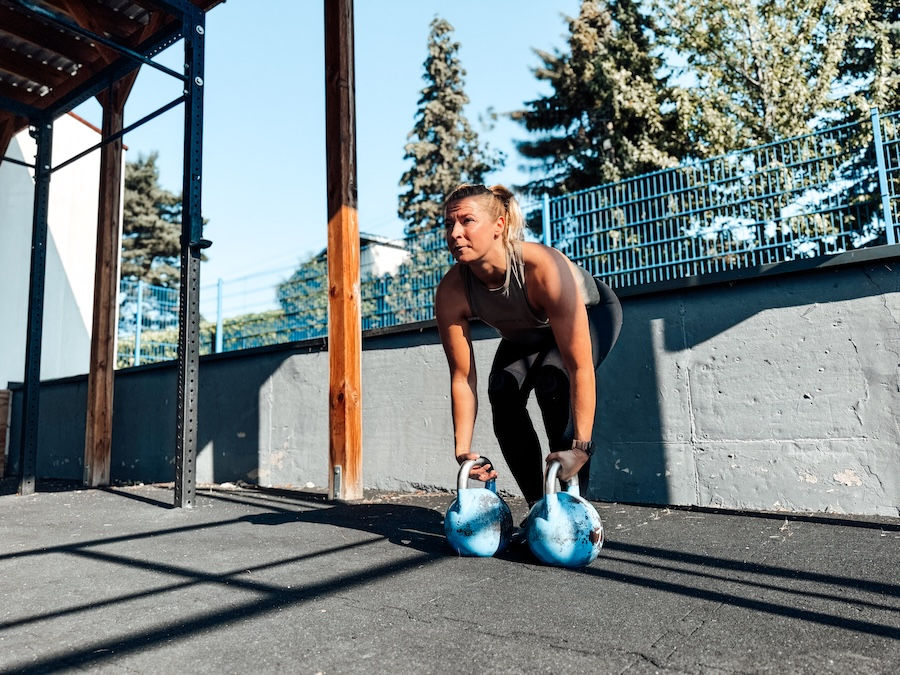Progression in Training: How to Become Stronger, Faster, and Fitter on a Bontinuous Basis
- Lin ny
- Aug 10, 2025
- 7 min read
Updated: Aug 12, 2025
You exercise regularly, give it your all—and yet it feels like you're treading water? This is rarely due to a lack of motivation.
Most of the time, there is no system that forces your body to continue adapting: progression in training.
Progress is not a coincidence, but the result of small, planned improvements.
In this article, we'll show you how to understand progression, apply it smartly, and get measurably better step by step—in strength, endurance, and flexibility.
What does progression mean in training?

Progression means increasing the training stimulus in a targeted manner. Not recklessly, not every day, but in small, achievable steps.
Your body reacts to stimuli. If the stimulus remains the same, performance remains the same. If the stimulus increases, the body adapts.
Strength: more weight, more repetitions, an additional set, shorter breaks, a more controlled pace, or a more difficult variation (e.g., front squat instead of back squat).
Endurance: longer distances, faster pace, more intense intervals, hills or technical challenges.
Mobility: longer holding times, greater range of motion, more complex sequences, active rather than passive stretching.
What is the difference between beginner and advanced progression?
Beginners: quick adjustments, weekly increases are normal. Mini steps are enough.
Advanced: smaller jumps, more planning, targeted cycles, and deloads. Progress is slower—but more stable.
Why is progression important in training?

It's simple: your body is lazy. It only does what it absolutely has to. If you give it the same workout stimulus week after week, it thinks, “Okay, I can do that, why should I invest more energy?” – and that's exactly why you're not making any progress.
Progression forces your body to adapt a little bit at a time.
This could mean more weight, more repetitions, a faster pace, or even just cleaner technique. Every time you slightly increase the stimulus, your body has to respond: muscles get stronger, endurance improves, flexibility increases.
What happens in the body when I push myself harder?
Muscles & nervous system: You recruit more muscle fibers, improve coordination, increase fiber thickness, and intramuscular tension.
Cardiovascular system: Stroke volume increases, capillarization improves, and you transport oxygen more efficiently.
Connective tissue & joints: Tendons, ligaments, and cartilage adapt to regular, measured loads, increasing stability.
Why is success elusive without progression?
Same training → same output. You become more skilled, but not better. Progression provides the “reason” to develop more performance.
Progression in training: How can I improve systematically?

The secret is not to completely destroy yourself every workout. The secret is to take small steps consistently—and plan them.
If you increase your weight randomly (“let's just add 10 kg/20 lbs today”), you will either become frustrated or injured very quickly.
Systematic means: You choose one or two adjustments that you slowly turn over several weeks.
The most important methods that work:
Move more weight: The classic strength training exercise. Lift a little more each week – 2.5 kg is often enough.
More repetitions or sets: Same weight, but more work. Turn 3×8 into 3×10 or 4×8.
Shorter breaks: Same work in less time. Works well for endurance and Metcon sessions.
Higher training frequency: Train an exercise or a movement range more often per week.
Cleaner technique & greater range of motion: Bend deeper, land more stable, execute more controlled – that's also progression.
More complex variations: From simple to more difficult movements: Push-up → one-arm push-up.
Change tempo: Slow down, explode up – or incorporate breaks in the most difficult position.
How can I combine these methods effectively?
Work in blocks: focus on one main method for 3–4 weeks, then supplement with a secondary method.
Example: 4 weeks of “more weight” + “same volume”; then 4 weeks of “same weight” + “more volume.” This way, you always set new goals without exhausting yourself.
How quickly should I increase my training?

You'd probably love to break a new record every week. Sounds good – but it only works at the very beginning.
Finding the right pace is a balancing act: too fast and you risk overexertion or injury, too slow and you'll be treading water.
Better: small, achievable steps.
Strength training for beginners: Increase weight by 2.5–5% each week as long as your technique remains perfect.
Strength training for advanced athletes: Increase every 2–3 weeks or work on increasing volume/speed.
Endurance: Increase distance by 5–10% per week or slightly increase speed.
Mobility: Increase hold times or range of motion a little each week.
How can I tell if I am pushing myself too hard?
Technique breaks down
Pain instead of “normal” muscle soreness
You are constantly exhausted and do not recover
And too slow?
Several weeks of identical values with no progress
No real effort in training
Motivation drops
Tip: Increase the intensity so that you still have 1–2 clean repetitions left in the tank during training. This will keep you healthy in the long term – and still help you make steady progress.
How do I implement progression in strength training?

Strength training is the perfect playground for progression—here you can measure your progress quite accurately. The goal is simple: over time, your muscles should be able to move more weight in a controlled manner.
To make this work, you need a plan and small, steady increases. Here's how it could look:
1. Increase weight – but in small increments
Beginners: Add 2.5–5% more weight each week as long as your technique remains clean.
Advanced: Increase every 2–3 weeks, but work on volume or speed more often.
Example: Squats (3 times a week): Week 1: 3 sets of 8 with 40 kg → Week 2: 3 sets of 8 with 42.5 kg → Week 3: 3 sets of 8 with 45 kg.
2. More repetitions or sets
Instead of immediately increasing the weight, you can first increase the volume.
3×8 → 3×10 → 4×8
Works well if the current weight is still manageable but challenging.
3. Improve technique and range of motion
Going deeper into squats or lowering yourself more slowly when bench pressing is also progression—and often more strenuous than you think.
4. Incorporate more complex variants
Once you feel comfortable with the basics, try more difficult movements:
Squat → Front squat
Pull-up with band → Strict pull-up
Deadlift → Deficit deadlift
5. Control tempo and pauses
Slow eccentric phases (e.g., 3 seconds down) or shorter breaks between sets increase the training density without adding weight.
Tip: Plan 4–6 weeks in advance how you want to increase your training. After each session, write down the weight, repetitions, and how you feel (RPE). This way, you'll know exactly when it's time to take the next step.
How do I implement progression in endurance training?

Endurance training is not about turning every run into a competition. It's about regularly pushing your body a little bit further so that your heart, lungs, and muscles learn to work more efficiently.
There are three main levers you can pull:
1. Increase volume
That's the easiest way.
Increase your distance or duration per week by a maximum of 5–10%.
Example: You currently run 5 km → next week 5.3–5.5 km.
This also works with time: from 30 minutes to 33 minutes.
2. Increase speed
Once you can comfortably run a distance, you can increase your pace.
Run one session per week at a slightly faster pace than normal (“speed run”)
Use interval training: e.g., 6×1 minute fast, 1 minute easy.
3. Shorten breaks
In interval or circuit training, you can increase the stimulus by shortening the recovery phases.
Example: 90-second break → 60-second break, same intensity.
Example: 5 km (3.1 mi) progression over 8 weeks
Weeks 1–2: 3 runs/week – 1× easy, 1× short intervals, 1× slightly faster
Weeks 3–4: Increase distance by 5%, extend intervals
Weeks 5–6: Incorporate a tempo run (just below race pace)
Week 7: Maintain volume, focus on pace
Week 8: 5 km test run – compare target time
Tip: Track every session – whether using a watch, training diary, or an app such as the SmartWOD Workout Generator. When you see in black and white that you are running further or faster, your motivation will automatically remain high.
How do I integrate progression into functional training/CrossFit?

In functional training or CrossFit, there are endless ways to improve—and not all of them involve lifting heavier weights.
Here you progress through load, speed, number of repetitions, technique, and skills.
The trick is not to try to improve everything at once. Focus on one or two clear goals in a 4–6-week block.
1. Increase load
When working out with barbells, kettlebells, or dumbbells, you can increase the weight in small increments.
Example: “DT” with 35 kg → 37.5 kg → 40 kg, as long as you can maintain the technique.
2. More work in the same amount of time
AMRAPs (“As Many Rounds As Possible”) are perfect for this:
Week 1: 8 rounds in 12 minutes
Week 4: 9–10 rounds in 12 minutes – same exercises, more work.
3. Same work in less time
For time workouts such as “Fran” or “Helen” are all about beating the clock without compromising on technique.
Focus: Faster transition between exercises, shorter breaks, clean repetitions.
4. Build skills
Progress also means learning or refining movements:
Pull-up → Chest-to-bar Pull-up → Muscle-up
Handstand → Handstand Walk
Double Unders instead of Single Unders
Break the skill down into small building blocks and increase the number of repetitions or hold time week by week.
5. Improve technique under fatigue
In CrossFit, it's not just about whether you can do the skill – it's also about whether you can do it when you're out of breath. You can train this by deliberately placing the skill in the middle of a workout when your heart rate is high.
Tip: Write down every benchmark time, every AMRAP round, and every skill level. In a few months, you'll see in black and white how much better you've become—even if it doesn't feel like it in the meantime.
Small steps, big impact
Progression is no secret. It's the art of planning small increases consistently and remaining patient.
You don't have to break records every week. You just have to be a little better today than you were last week—cleaner, heavier, faster, or more controlled.
Then progress will come automatically. Not spectacularly overnight—but reliably, noticeably, and sustainably.




Comments